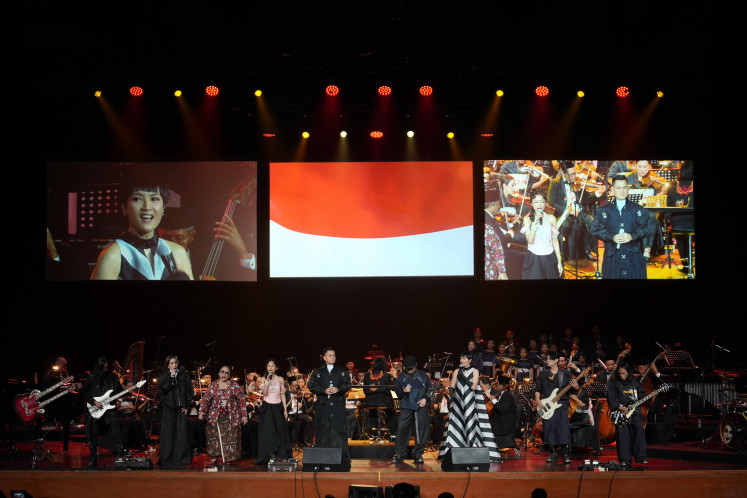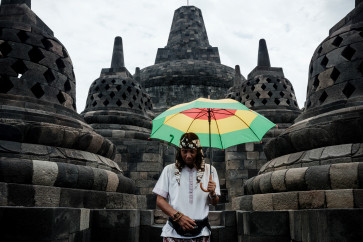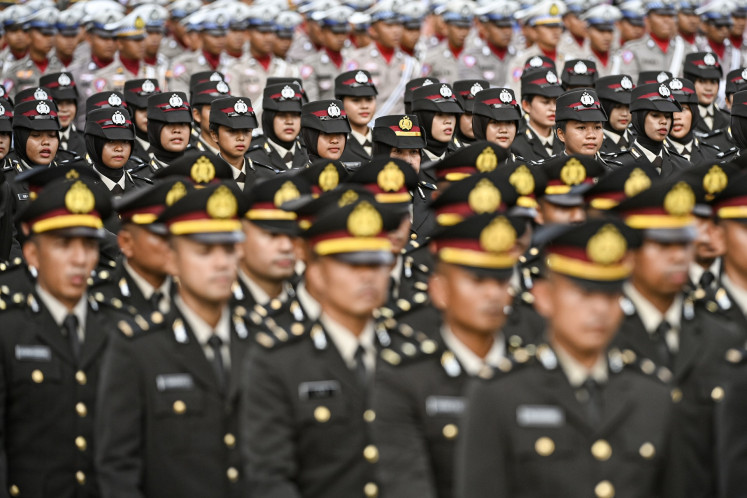Popular Reads
Top Results
Can't find what you're looking for?
View all search resultsPopular Reads
Top Results
Can't find what you're looking for?
View all search resultsMarking a palace anniversary with a special dish
(Ade Rizal)Hundreds of members and relatives of the sentana dalem, or royal family, gathered at the Kasunanan Surakarta Palace in full traditional costumes to mark the 270th anniversary of the palace on Monday
Change text size
Gift Premium Articles
to Anyone
 Delivery order:: Palace workers carry some of the 17 different types of porridge typically made to mark the founding of the Surakarta Palace. (Ade Rizal)" height="338" width="510" border="0">Delivery order: Palace workers carry some of the 17 different types of porridge typically made to mark the founding of the Surakarta Palace. (Ade Rizal)
Delivery order:: Palace workers carry some of the 17 different types of porridge typically made to mark the founding of the Surakarta Palace. (Ade Rizal)" height="338" width="510" border="0">Delivery order: Palace workers carry some of the 17 different types of porridge typically made to mark the founding of the Surakarta Palace. (Ade Rizal)Based on the Javanese calendar, the palace turned 278 this year, although the common calendar fixes the age of the building at 270.
Accoding to Kanjeng Pangeran Winarnokusumo, the palaceâs deputy internal affairs director (the title refers to closeness to power, not to rooting out corruption) said that jenang Suran was the primary dish of the commemoration due to its symbolic meaning of safety or security and for expectations of a future better than today.
Jenang Suran is white rice porridge that is very soft and tastes sweet. White represents virtue. âThe porridge has a soft texture, which serves to remind us of our weak standing before God. So we should always remember God and live a religious life,â Winarnokusumo said.
The porridge is garnished with side dishes such as scrambled eggs, perkedel (potato croquettes with spicy meat), tempeh fermented soybean cakes, spicy sauce, cucumbers and basil leaves.
The side dishes symbolize human diversity, whose beauty is further enhanced if the whole mankind lives peacefully.
 Delivery order: <)
Delivery order: <)
(Ade Rizal)
Hundreds of members and relatives of the sentana dalem, or royal family, gathered at the Kasunanan Surakarta Palace in full traditional costumes to mark the 270th anniversary of the palace on Monday.
The palace was also packed with hundreds of royal servants (abdi dalem), some of who were busily preparing a special dish for the auspicious occasion.
Two servants clad in black, for example, were seen shouldering a palette of jenang Suran rice porridge, the main dish served to mark the event, called Wilujengan Hadeging Keraton Kasunanan Surakarta.
Delivery order: Palace workers carry some of the 17 different types of porridge typically made to mark the founding of the Surakarta Palace. (Ade Rizal)
Based on the Javanese calendar, the palace turned 278 this year, although the common calendar fixes the age of the building at 270.
Accoding to Kanjeng Pangeran Winarnokusumo, the palace's deputy internal affairs director (the title refers to closeness to power, not to rooting out corruption) said that jenang Suran was the primary dish of the commemoration due to its symbolic meaning of safety or security and for expectations of a future better than today.
Jenang Suran is white rice porridge that is very soft and tastes sweet. White represents virtue. 'The porridge has a soft texture, which serves to remind us of our weak standing before God. So we should always remember God and live a religious life,' Winarnokusumo said.
The porridge is garnished with side dishes such as scrambled eggs, perkedel (potato croquettes with spicy meat), tempeh fermented soybean cakes, spicy sauce, cucumbers and basil leaves.
The side dishes symbolize human diversity, whose beauty is further enhanced if the whole mankind lives peacefully.
Guests of the sultanate assemble to mark the palace's anniversary (top, bottom), as a palace worker presents a special dish (middle left), some of which are seen on the table (middle right). (Ade Rizal)
'In this Surakarta palace anniversary celebration, the royal family wishes to invite the public as well as the government to conduct an introspection. Let us all be introspective so as to become better citizens and bring greater benefit to public life,' Winarnokusumo said.
A patron of the Indonesian Porridge Foundation, Slamet Raharjo, said that jenang was more than a ceremonial food offering in Javanese culture. 'The porridge served is steeped in philosophy and embodies the good wishes of the hosts organizing relevant celebrations.' Jenang Suran was among the 17 types of porridges made to mark the palace's founding, he adds. 'The others are, for instance, jenang Abrit Petak, Lang, Manggul, Sum-sum and Saloko, each representing a prayer for the royal family.'
The anniversary itself refers to the Boyong Kedhaton, or the day the seat of the Mataram Kingdom moved from the Kartasura Palace to Kasunanan Surakarta Palace.
Kanjeng Gusti Pangeran Haryo Puger, the museum and tourism director of the palace said that Kartasura collapsed following an attack from the rebel Raden Mas Garendi. 'The kingdom was then under Pakubuwana II. At the time, a kingdom facing a rebellion had to move, which led to the exodus to Surakarta'.
The story, told in traditional chronices such as the Babad Tanah Jawi and Babad Kartasura Pacinan, has it that the kingdom should have rulers from all four directions: Kanjeng Sunan Lawu from the east, Ratu Kencono Sari from the south, Sekar Kedhaton from the west and Bathari Kala Yuwati from the northern Krendowahono forest. Owing to the four rulers' support, every anniversary commemoration must include a dhukutan kiblat papat or four-direction ritual prayer service, held at the sasana handrawina, the royal dining hall of the palace.











